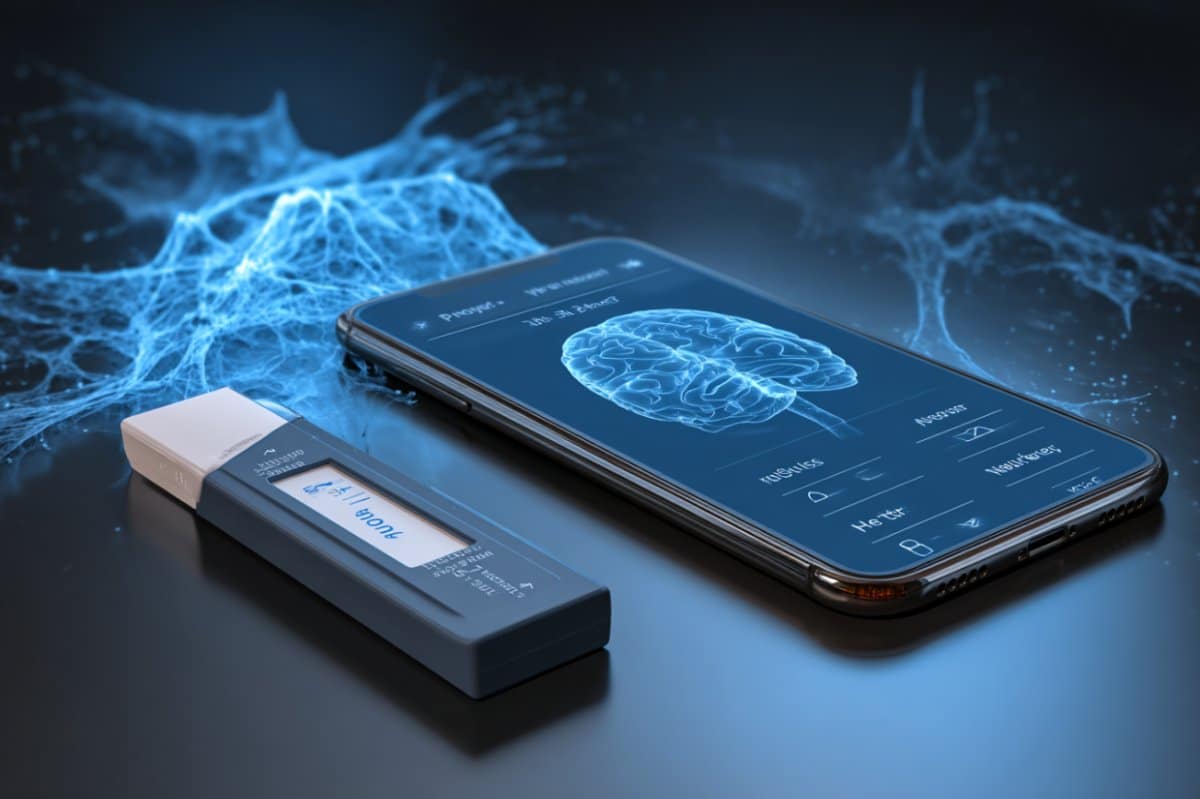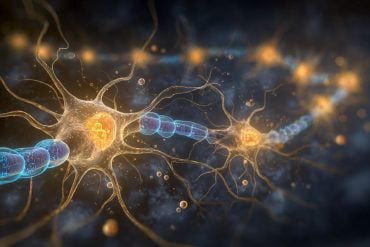Summary: Scientists have developed a portable biosensor that can detect levels of BDNF, a protein linked to mental health conditions such as depression, schizophrenia, and bipolar disorder. The flexible, low-cost device analyzes a drop of saliva in under three minutes, offering a fast, affordable, and noninvasive diagnostic tool.
Because low BDNF levels are associated with depression and cognitive decline, the test could help clinicians detect and monitor disorders earlier. With an estimated cost of just $2.19 per unit, the biosensor could transform mental health screening, especially in low-resource settings.
Key Facts
- Rapid Results: The saliva-based biosensor measures BDNF levels in less than three minutes.
- Affordable Innovation: Each unit costs around $2.19, making it accessible for widespread use.
- Clinical Relevance: Low BDNF levels are linked to depression, while increases can track recovery
Source: FAPESP
Brazilian researchers have developed a low-cost, portable biosensor that can quickly identify a protein whose altered levels are associated with psychiatric disorders, such as depression, schizophrenia, and bipolar disorder.
When it becomes commercially available in the future, it may contribute to early detection, which is essential for treating and monitoring patients’ clinical conditions.

The biosensor is the result of a partnership between researchers at the University of São Paulo (USP) and Embrapa Instrumentação, a decentralized unit of the Brazilian Agricultural Research Corporation (Embrapa). It consists of a flexible strip with electrodes that, when integrated with a portable analyzer, evaluates drops of human saliva.
In less than three minutes, the biosensor provides the concentration of BDNF (brain-derived neurotrophic factor), a protein crucial for the growth and maintenance of neurons and the development of brain functions, including learning and memory.
The research, published in ACS Polymers Au, shows that the device can reliably measure extremely low concentrations of the protein in a wide range of saliva (from 10⁻²⁰ to 10⁻¹⁰ grams per milliliter), down to minimal amounts that are still detectable (1.0 × 10⁻²⁰ grams per milliliter).
The biosensor has an estimated cost of US$2.19 per unit — less than R$12.00 at the current exchange rate — and long-term storage capacity. According to the scientists, the next step is to obtain the patent.
“There are few sensors that perform this type of analysis, and ours was the one that performed best. It detected a wide range of concentrations, which is a very good result from a clinical point of view. When protein levels are very low, it can serve as a warning sign for diseases and psychiatric disorders.
“On the other hand, by being able to signal an increase in BDNF, it contributes as a tool to monitor the patient’s progress according to the treatment,” explains Paulo Augusto Raymundo Pereira, a researcher at the São Carlos Institute of Physics (IFSC-USP) and corresponding author of the article, in an interview with Agência FAPESP.
Pereira, who has experience in chemistry and biotechnology, has been working with flexible sensors and electrochemical biosensors. Last year, he was one of the authors of an article in the Chemical Engineering Journal that presented the results of a portable sensor for urine self-testing aimed at detecting markers of diseases such as gout and Parkinson’s.
Link to disorders
Scientific literature shows that low levels of BDNF are one of the factors involved in some neurological and psychiatric disorders associated with cognitive decline.
Depression is one such disorder. The effect of the protein is restored by antidepressants. Healthy individuals have BDNF levels above 20 nanograms per milliliter (ng/mL), whereas people with major depressive disorder (MDD) have levels below 10 or 12 ng/mL.
According to data from the World Health Organization (WHO), more than 1 billion people live with mental disorders, with anxiety and depression being the most prevalent conditions.
According to the organization’s reports, including the Mental Health Atlas 2024, these disorders have increased in prevalence in all countries, affecting people of all ages and income levels.
Between 2022 and 2024, worker absences due to mental health issues in Brazil increased by 134%. According to the Occupational Safety and Health Observatory, these absences rose from 201,000 to 472,000 and were caused by episodes of depression, anxiety, and recurrent depression.
Pereira adds, “The increase in cases of mental disorders and the consequent rise in the use of medication, especially after the COVID-19 pandemic, motivated us to work on this issue and seek alternatives.” Pereira has the support of FAPESP through scholarships (16/01919-6, 23/09685-8, and 22/02164-0).
The device
The researchers developed a flexible strip screen-printed on a polyester film substrate with three electrodes: one functionalized working electrode, one pure carbon auxiliary electrode, and one silver reference electrode.
The working electrode was modified with carbon nanospheres. It received a layer of two chemical compounds – polyethyleneimine and glutaraldehyde – to increase sensitivity and act as a matrix to immobilize the BDNF-specific capture antibody (anti-BDNF). To prevent other types of interaction, a reactive layer of ethanolamine was added.
BDNF detection is based on the formation of antibody-antigen immunocomplexes, which increase resistance to electron transfer on the sensor surface. This growth is captured by electrochemical impedance spectroscopy, a technique used to study processes that occur at the interface between an electrode and a solution.
The results can be displayed in real time on a mobile device (smartphone) via wireless communication (Bluetooth).
The current techniques used to analyze BDNF levels include the enzyme-linked immunosorbent assay (ELISA), electrochemiluminescence, fluorescence, and high-performance liquid chromatography (HPLC). These techniques require time, large sample volumes, and specialized laboratories.
“We’re moving toward personalized medicine, in which treatments will be increasingly tailored to each individual. In the case of the biosensor, it can be optimized to suit different profiles,” says the researcher.
Funding: FAPESP also supported the study through the Thematic Project “Towards the Convergence of Technologies: From Sensors and Biosensors to Information Visualization and Machine Learning for Data Analysis in Clinical Diagnosis”, as well as two other projects (23/07686-7 and 20/09587-8).
The team includes the following researchers: Nathalia Gomes, Marcelo Luiz Calegaro, Luiz Henrique Capparelli Mattoso, Sergio Antonio Spinola Machado, and Osvaldo de Oliveira Junior.
Key Questions Answered:
A: It measures concentrations of brain-derived neurotrophic factor (BDNF), a key protein tied to neuron health and mental well-being.
A: Low BDNF levels are associated with depression, schizophrenia, and cognitive decline, while antidepressants help restore them.
A: By offering quick, low-cost, noninvasive BDNF testing, it could help identify early warning signs and monitor treatment progress in psychiatric disorders.
About this mental health and neurotech research news
Author: Heloisa Reinert
Source: FAPESP
Contact: Heloisa Reinert – FAPESP
Image: The image is credited to Neuroscience News
Original Research: Open access.
“Low-Cost, Disposable Biosensor for Detection of the Brain-Derived Neurotrophic Factor Biomarker in Noninvasively Collected Saliva toward Diagnosis of Mental Disorders” by Paulo Augusto Raymundo Pereira. ACS Polymers Au
Abstract
Low-Cost, Disposable Biosensor for Detection of the Brain-Derived Neurotrophic Factor Biomarker in Noninvasively Collected Saliva toward Diagnosis of Mental Disorders
The importance of early detection of neurodegenerative disorder biomarkers has grown since these biomarkers are essential for timely diagnosis, treatment, healthcare, and wellness applications.
We present a cost-effective and disposable electrochemical immunosensing strip for rapid, decentralized detection of brain-derived neurotrophic factor (BDNF)─one of the major neurotrophins (NTs) associated with neurological and psychiatric disorders─in human saliva.
The salivary BDNF immunosensor strip is made on a screen-printed carbon electrode functionalized with carbon spherical shells (CSSs), polyethylenimine (PEI), and glutaraldehyde to enhance sensitivity.
Through systematic optimization, the sensor achieved excellent analytical performance, with a wide dynamic detection range from 1.0 × 10–20 to 1.0 × 10–10 g mL–1, a rapid response time of under 3 min, and an ultralow detection limit of 1.0 × 10–20 g mL–1 for BDNF in human saliva.
The BDNF immunosensor demonstrated high selectivity, reproducibility, robustness, stability, and long-term storage capability.
At a cost of less than US$ 2.19 per unit, this disposable sensor also enabled rapid BDNF detection in saliva samples collected from healthy volunteers without interference from other salivary constituents.
The environmental impact was assessed using the Analytical Eco-Scale (AES), the Analytical GREEnness Metric Approach (AGREE), and the Blue Applicability Grade Index (BAGI), which evaluates the practicality (“blueness”) of the device. These assessments confirmed the sustainability of the disposable BDNF immunosensor strip.
This device provides a rapid, efficient, cost-effective, and reliable method for the decentralized, noninvasive salivary analysis of BDNF, enabling broader applications in healthcare, wellness monitoring, and medical diagnostics related to the neurotrophin family of biomarkers.






